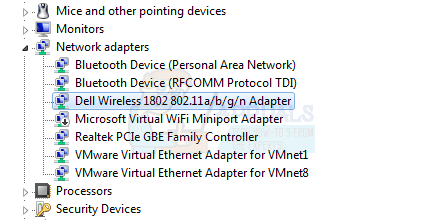This issue means that even though your router is able to emit at both frequencies, and you have it set up so it does (or the faster, 5GHz one only), you can’t find the network on your computer. This may be confusing, but the letters in the name of your router and wireless adapter after the 802.11 standard have an important role here. There are routers and adapters that can only work on 2.4GHz, and there are some that work with both.
To solve this issue, there are a few things that you should do. Keep in mind, however, that it is possible that you need to buy new hardware if for any reason you are dead set on using 5GHz.
Method 1: Check if your router and wireless adapter support 5GHz wireless
To do this, you will be required to do a bit of online research for your specific model. Follow the instructions to see if your router and adapter even support this frequency. Take a look at your router and see the model. Do a quick search online for that router, which should land you on the manufacturer’s website. What you’re looking for is either supported frequencies or supported radio bands. If the router supports a 5GHz wireless network, it will be stated in its specifications. If you can’t find such a thing, look for the letters after 802.11, and use the following information to figure out if you can use the 5GHz frequency:
the adapter supports 802.11a 5GHzthe adapter supports 802.11b 2.4GHzthe adapter supports 802.11g 2.4GHzthe adapter may support both 802.11n 2.4GHz, and 5GHz, but not necessarilythe adapter supports 802.11c 5GHz
Generally, a router that states it’s 802.11a/g/n, or 802.11ac will work at 5GHz. However, a router that is 802.11b/g/n has a slim chance of supporting that frequency, and you may need to upgrade. If your router supports 5GHz connectivity, the next thing to do is to check your adapter. Open Device Manager by pressing the Windows key on your keyboard, typing Device Manager and opening the result. From the list of drivers, you see in the Device Manager, expand Network Adapters and locate your wireless adapter. See its name, and see whether it says anything about the radio bands it supports. If it doesn’t say anything, use your favorite search engine to get to the manufacturer’s website, from where you can see whether it supports 5GHz using the guide mentioned in the first step. If your adapter supports 5GHz bandwidth, you can move on to the next method, which deals with issues with compatible hardware. If not, you will need to change the adapter on your computer in order to get your wireless working at 5GHz. Another way to check if your adapter has 5GHz capability is through the command prompt. Press Windows + R and type “cmd“. Once the command prompt comes forth, type “netsh wlan show drivers“.
Method 2: Enable 802.11n mode on your adapter
If your hardware is compatible with 5GHz bandwidth, but you still can’t use it, it might be simply disabled, in which case you will need to manually enable it. When you’ve done this, click OK and restart your computer. You should now be able to see your 5GHz network.
All things considered, it is fairly easy to get lost in the sea of standards currently available. However, following the aforementioned methods will give you a fully functional 5GHz network in no time, provided you have compatible hardware.
Fix: Windows 10 will not connect to WIFI AutomaticallyFix: iPhone won’t Connect to WifiNintendo 3DS or 2DS will not Connect to Wifi Error ‘003-1099’Fixed: PS5 Wont Connect To WiFi 2022



